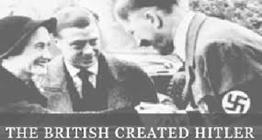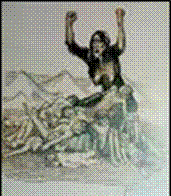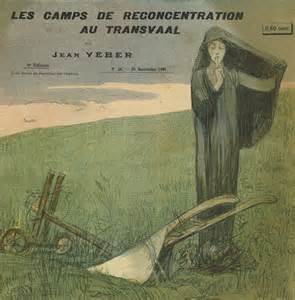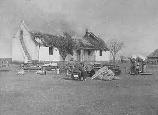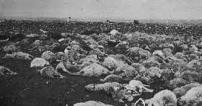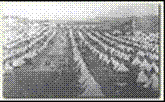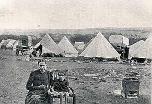
|
Unbanned Bible Publications |
|
Defending God’s Truth in Church Doctrine and Political History – Renette Vermeulen |
CONDEMNING HITLER’S NAZI CONCENTRATION CAMPS WHILE FORGETTING ABOUT BRITAIN’S DELIBERATE GENOCIDE IN SOUTH AFRICA?
[Acknowledgement to the person who compiled this image]
“HUSH OUR SOCIALIST FRIEND HITLER! NO ONE KNOWS WHAT WE REALLY DID TO THE WOMEN, BABIES, CHILDREN, OLD MEN, AND POWs! WE’LL SIMPLY TELL THE WORLD THEY WERE ‘BOER SOLDIERS’ THAT DIED IN THE WAR! IF THAT DOESN’T WORK, WE’LL TELL THEM THEY WERE ‘REFUGEES’ WHO FLED TO THE CONCENTRATION CAMPS FOR THEIR OWN PROTECTION!’”
Everyone should condemn the first concentration camp carnage of Spain in 1896-97 and Hitler’s genocidal atrocities during World War Two in the 20th century, but what about Britain’s much overlooked holocaust of shame in South Africa at the turn of the 19th century? This was clearly a full-blown, socialist concentration camp experiment, and it was designed to become an example to the rest of the communist world that followed during the 20th century and to this day. Queen Victoria annihilated innocent civilians in concentration camps long before Hitler did. The horrendous South African death camps, purposely designed to commit genocide on a massive scale, was also the direct result of Britain's inhumane War Propaganda when they allegedly came “to hunt wild boar,” the farmers or “Boers” of South Africa.
In 1900, after gaining control of the capitals of the Orange Free State and the ZAR, embarrassment mounted for Queen Victoria because her mighty armies, even with the militant assistance of her super powerful allies, could not conquer the great minority of “common Boers” man-to-man on the battlefield. The British could not tolerate political embarrassment in the world press, as their Empire was so vast, they proudly boasted that “The Sun Never Sets On Britannica!” To push the small minority of Afrikaner commandos into surrendering to their quest of world domination, the British Empire and her half-a-million strong Allied Forces began to forcibly abduct the ordinary civilians of two Republics, (people of all races, genders and ages,) to detain them in concentration camps on the open veldt and behind barbed wire fences under completely inhumane conditions.
[Acknowledgement to those who compiled the photos and images in this study]
The British still have the audacity to defend and euphemize their death camps as “protection against the scorched earth policy,” calling them “voluntary refugee camps.” Britain allegedly “protected” civilians who “flooded the camps, fleeing from the farms, because they could not support themselves with all the men on the battlefield.” The British, from the so-called ‘goodness of their hearts,’ then “tried their best to accommodate these desperately poor, homeless peasants, who were free to leave at any time.” Has everyone gone crazy? To stop the Afrikaner women and African workers from feeding the fighting commandos, Britain scorched the farms, abducted the very self-sufficient women, children, old men, servants, and their families, and forced them into concentration camps! Dr. Kendal Franks reported on the Irene (Pretoria East) Concentration Camp, “In one of the tents there were three families… a total of 14 people, all suffering from measles.” This only deals with measles as one of the major causes of deaths in the camps, while starvation and every other danger remain excluded. Measles is a highly contagious, viral disease. As late as 1980, with the help of global vaccinations, 2.6 million people still died from measles worldwide. One can only imagine the suffering and carnage, which Britain caused in only this one camp. Very suspiciously, no one seems to know where the Irene camp actually was, and, as elsewhere in the country, the awful conditions in this camp are either minimized or forgotten. The plaque at the memorial garden-cemetery, which is not the original camp site, states that an estimated 5,400 people were detained in the camp. Because accurate records do not exist, other sources differ. The plaque at the cemetery mentions an estimated 1,041 infants and children and supposedly only 149 adults, who were exhumed and reburied at this terrain some way from where the camp had been. We can be certain that, because the cemetery is nowhere near the camp site, the death statistics of adults are so low, and deaths among older children are not mentioned, there is a huge cover-up here. At first, Emily Hobhouse was not aware of the appalling death rates in the camps. Of her quest to improve basic hygiene and living conditions, Pakenham says, “…The full realization of the position dawned upon me – these were death rates such as had never been known except in the times of the Great Plagues… The whole talk was of death – who died yesterday, who lay dying today, who would be dead tomorrow.” What blatant lies did the British conjure up to cover their inhumane disregard for South African citizens, their families and workers; their hard-earned possessions, livelihood, and innocent animals and livestock! Www.bbc.co.uk wrote, “The bad administration of the camps led to poor quality food [and a deliberate lack of clean water, shelter, food,] immense overcrowding, unhygienic conditions, and inadequate medical arrangements. Civilians suffered terribly…” The truth is that the dire conditions in Britain’s concentration camps were not due to ‘bad management’ or ‘a lack of planning.’ Such misconceptions are huge understatements of the mass starvation and diseases that Britain unleashed on the defenseless citizens of the two Republics.
MYSTERY SURROUNDS THE TERRIBLE TURFFONTEIN CONCENTRATION CAMPMy son Glen brought to my attention that the Turffontein Concentration Camp in the South of Johannesburg, which British sources say, contained “about” 5,000 people, remains a great enigma to everyone who knows about it and tries to solve the riddle that surrounds it. That night, I had a dream ‘titled:’ Interview With A Ghost. I asked the ghost sitting opposite me, “How long have you been underground?” Silence. “How many are buried there with you?” Silence. “Where are you buried, exactly?’ Silence. “How did you die?” Silence... And so the interview went until I woke. When I told Glen about it, he said, “It seems we will never know what really happened there.” The British recorded “only” 704 deaths at this camp, all neatly buried some five kilometres away across the steep Johannesburg mountains and valleys in Suideroord — nowhere near Turffontein, where the camp used to be. We might never know exactly how many people were detained in this camp, as circumstances surrounding this camp, (as in all the other camps,) raise the suspicion that real death statistics at this camp either never existed, or were deliberately destroyed. The British started this concentration camp at The Mayfair School, but soon ran out of space. They then relocated their detainees to an open space close to the Wemmerpan Lake in Turffontein, part of which was used for horse racing before the war. This camp too, was quickly overcrowded with the constant, forceful shoving in of people who were abducted from the farms. After the war, the British cleaned a portion of this appalling site to restore the Turffontein Race Course. If they did this to conceal the misery and death they inflicted on thousands of civilians there, beautiful race horses and greedy men quickly helped everyone to forget what crimes Britain had committed on this site. What happened in the Turffontein concentration camp was so appalling that the official Johannesburg website wrote, “The barely-known Cornelis Broeksma exposed these conditions and for his effort he was executed by [British] firing squad at the Johannesburg Fort, [30 September 1901. The Old Fort is now called “Constitution Hill.”] The hero Cornelis Broeksma was an attorney from Holland, and during the Boer War he practiced in Johannesburg…. He also visited the [Turffontein] concentration camp. Appalled by what he saw, he started recording the number of deaths. This information made its way in code to… Amsterdam, but along the way, it got into the hands of the British. Cornelis Broeksma was arrested, tried for treason, and executed at the Fort. Cornelis Broeksma was buried at the Fort, but his body was later exhumed and buried at the Braamfontein Cemetery.” The British Government callously murdered this brave witness to conceal their mass murder at the Turffontein concentration camp! This proves that the alleged 5,000 people who were detained there, and the so-called 704 concentration camp victims who were buried in Suideroord, about five kilometres from Turffontein as the crow flies, is an unscrupulous cover-up! It seems that conditions in this camp were the worst among all, (seeing that the British even resorted to publically murdering a whistle-blower to cover their crimes there,) which could have resulted in the highest death rate among all the camps. Considering the fact that the large Wemmerpan Lake was so close to the camp, the inhumane cruelty of the British slowly becomes apparent. They had absolutely no reason to withhold enough clean drinking and washing water from the detainees in the camp. Yet, Cornelis Broeksma found that conditions in the camp were abysmal. Apparently, out of fear for their lives, no one else noticed that scores of helpless people were dying of diseases and starvation without anyone caring exactly how many casualties there were; how many actually died, and what really became of all the corpses, which had to result from such deliberate overcrowding and torture. The overall death rate among women, infants, children and old men in the camps was at least 34% and higher according to statistics in the other camps. Even if there were “only” 5,000 people detained there, that makes for at least 1,700 dead, not 704! Mystifyingly, the Turffontein camp was situated not far from the inner city of Johannesburg with its encroaching industrial and residential areas; right across the street from the redundant Main Reef Gold Mine in Turffontein Road. Yet, the British had great open spaces surrounding the city where they could have erected the camp — and where they could have made a cemetery for the camp. Instead, with all that open space, the British began to use this open mine as a landfill site, which now, 121 years later, has grown into an enormous mountain of rubbish virtually inside the city, covering a huge portion of Turffontein through into Booysens. The open mine was very convenient to dispose of all types of waste. A gold mine is a very deep hole in the ground. No one might ever know what was really buried under that mountain of rubbish. But I believe this convenient redundant mine across the road from the Turffontein camp solves the riddle why most of the other concentration camps had their cemeteries next to, or at least close to the camp — except this one. The only proof that the Turffontein concentration camp existed can be found at the Suideroord memorial. No mention or details of the existence of a concentration camp are recorded or displayed near the Turffontein site where the actual camp used to be. So, why would the British escort their detainees all the way across the mountains to bury their loved ones with so much available space around the camp? If the British did not intend to start another cemetery in or near the city, the Braamfontein cemetery, established in 1888, would have been closer, more convenient to use, and definitely able to accommodate the so-called “704” victims from the camp. Why would they go to such time-consuming, laborious, and expensive lengths to cart the bodies of their victims across the mountains? Makes no sense at all. Unless of course, if the British intentionally chose this location in Turffontein Road, directly opposite the open, redundant mine, to erect a death camp, not “merely” a torturous starvation camp. Could there have been a more convenient place to get rid of thousands of corpses? From the origin of this horrible piece of history, the origins of that huge mountain of rubbish, which now covers the deep depths of the redundant mine, were obscured and not merely circumstantial.
Below from left: Snow in the Springfontein concentration camp where virtually no shelter existed; immensely overcrowded camps; and the little corpse of Guysbert Johannes Vermeulen, 12 years old.
[Acknowledgement to those who compiled the images in this study] Above, second row on left: The corpse of Francois Michiel Alexander, 16 years old, but looking like that if a little boy; a depiction of women being driven to the camps; and farmers arriving at their torched homes and ‘scorched’ farms. WAR CRIMES ON THE FARMS AND IN THE CAMPS SCREAM FOR JUSTICEToday, in 2013, one British pound from 1900 is worth R28,626.00 (ZAR). What was the royal head of Queen Victoria on her one-pound coin worth in terms of innocent blood during her gold-grabbing, genocidal war between 1899 and 1902? Could all the gold of South Africa’s infinitely rich gold mines pay for the life of just one person, callously dispossessed, raped, starved, murdered, and then unscrupulously discarded somewhere on the outstretched fields of this once flourishing country — or in one of its redundant mines? The artist Willem Boshoff stated, “I tried to find a Boer home dating back to that time and failed – there doesn’t seem to be one. One is also not likely to find any period furniture from that time. All was burnt up. A holocaust… totally consumed by fire… Horses and cattle burnt into a stinking disgrace…”
[Acknowledgement to those who compiled the photos and images in this study] I could find virtually no information on African concentration camps, except the example of these two photos among the others. It is believed that the British made conditions in the African camps even worse than in the atrocious Afrikaner camps. The last two photos in the bottom row are of POW’s in the Madras camp, India, and of the Madras camp itself. Conditions in these camps were also appalling. My own great-grandfather remained imprisoned for seven years in Ahmednagar camp in Maharashtra, India, until he eventually accepted the pledge of allegiance to the British crown and was allowed to return to South Africa. |
